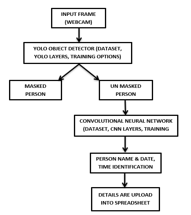COVID-19 Monitoring System using Social Distancing and Face Mask Detection on Surveillance video datasets
Objective
This work proposes face detection and face mask classification using object detection, clustering and Convolution Neural Network (CNN)
Abstract
The new Coronavirus (COVID-19) has affected the world seriously. According to estimates from the World Health Organization (WHO), the worldwide number of novel coronaviruses already has passed 60 million+ and 1,410,378+ fatalities. The compulsory face mask restrictions are increasingly standard in public environments across the world to limit the spread of the disease.
Additionally, many public service providers, educational institutions, offices etc., made a mandatory rule to wear face-masks. These developments inspired research into automatic (computer-vision-based) techniques for face-mask detection that can help monitor public behavior and contribute towards constraining the COVID-19 pandemic.
Although existing research in this area resulted in efficient techniques for face-mask detection, these usually operate under the assumption that modern face detectors provide perfect detection performance and that the main goal of our method is to detect the presence of face-masks and updating the details of the person into spreadsheet in case of no face mask.
This work is developed using YOLOv2 Algorithm for detection of face mask and Convolutional Neural Networks (CNN) for classifying the person.
Keywords: COVID-19, Masked-face detection, Face-mask classification, Face-mask recognition, COVID-19 compliant mask detection.
NOTE: Without the concern of our team, please don't submit to the college. This Abstract varies based on student requirements.
Block Diagram

Specifications
Software: Matlab 2020a or above
Hardware:
Operating Systems:
- Windows 10
- Windows 7 Service Pack 1
- Windows Server 2019
- Windows Server 2016
Processors:
Minimum: Any Intel or AMD x86-64 processor
Recommended: Any Intel or AMD x86-64 processor with four logical cores and AVX2 instruction set support
Disk:
Minimum: 2.9 GB of HDD space for MATLAB only, 5-8 GB for a typical installation
Recommended: An SSD is recommended A full installation of all MathWorks products may take up to 29 GB of disk space
RAM:
Minimum: 4 GB
Recommended: 8 GB
Learning Outcomes
- Introduction to Matlab
- What is EISPACK & LINPACK
- How to start with MATLAB
- About Matlab language
- Matlab coding skills
- About tools & libraries
- Application Program Interface in Matlab
- About Matlab desktop
- How to use Matlab editor to create M-Files
- Features of Matlab
- Basics on Matlab
- What is an Image/pixel?
- About image formats
- Introduction to Image Processing
- How digital image is formed
- Importing the image via image acquisition tools
- Analyzing and manipulation of image.
- Phases of image processing:
- Acquisition
- Image enhancement
- Image restoration
- Color image processing
- Image compression
- Morphological processing
- Segmentation etc.,
- About Artificial
Intelligence (AI)
- About Machine
Learning
- About Deep
Learning
- About layers in
AI (input, hidden and output layers)
- Building AI
(ANN/CNN) architecture using Matlab
- We will
able to know, what’s the term “Training” means in Artificial Intelligence
- About requirements that can influence the AI training process:
- Data
- Training data
- Validation data
- Testing data
- Hardware requirements to train network
- How to detect an object using AI
- How to extend our work to another real time applications
- Project development Skills
- Problem analyzing skills
- Problem solving skills
- Creativity and imaginary skills
- Programming skills
- Deployment
- Testing skills
- Debugging skills
- Project presentation skills
- Thesis writing skills





 Paper Publishing
Paper Publishing
